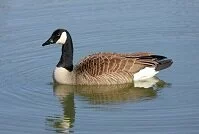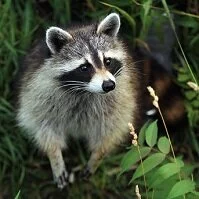Wildlife

Canadian Goose
As a northern country Canada's wildlife is very limited in scope, but its uniqueness and preservation of those animals make the wildlife more impressive than many other places. Most of the best known animals in Canada are mammals and birds. Among the large mammals are buffalo, caribou, grizzly and polar bears, mountain lions (cougar/puma), deer, and more. There are also dozens of mid-sized and small mammals including badgers, beavers, hares, coyotes, fox, raccoons, skunks, mice, and squirrels. Just off the coasts are water mammals including whales, dolphins, and porpoises.

Racoon
The sea life in Canada is also impressive, mostly due to their long ocean border. Although there are many fresh water fish in lakes and rivers, such as perch, Canada is more well known for their saltwater animals including salmon, lobster, and other fish and shellfish.
The bird life is also fairly diverse as there are many water fowls and forested birds. The most common among these are robins, blue jays, chickadees, geese, loons, and owls. Many of these birds and others migrate to and from Canada so few stay the winter. Due to the northerly climate and weather there are very few reptiles or amphibians in Canada, although they do have their share of insects in the summer months.